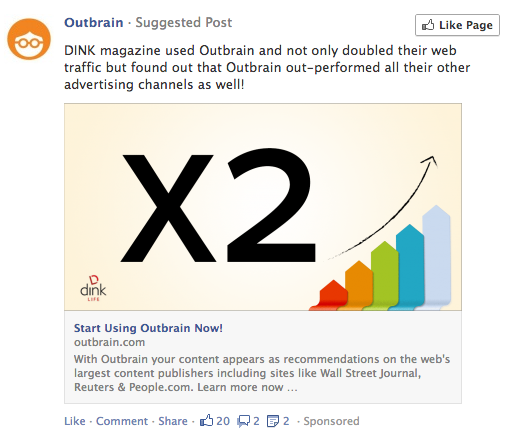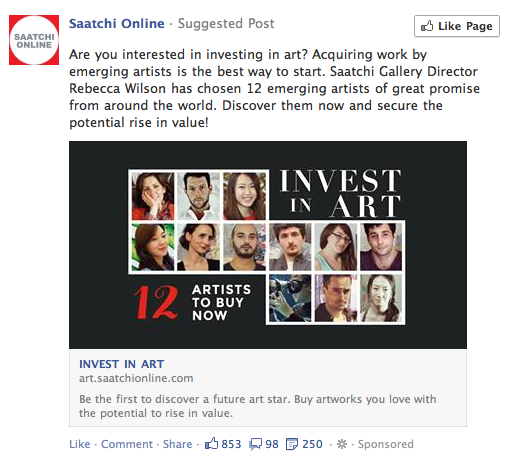I often think about how unfortunate it was that Facebook adopted a Pay-Per-Click advertising model when it first introduced its advertising feature.
Unfortunate because PPC was intimately associated with Google’s Adwords advertising model — a direct response model if ever there was one. But Facebook is really the wrong platform for DR-style ads.
Can it be made to work on a PPC or DR model? Sure it can.
Is that really it’s optimal or best use? No. Not according to most Facebook Advertising professionals. In fact, I would argue that Facebook is a much better branding platform. Here’s why:
1) What gets added to people’s news feeds gets added to their environment.
A Facebook ad that’s in the newsfeed itself becomes part of that Facebook users media environment, just as if it was a radio ad playing in the background. Or a TV Ad they aren’t really paying attention to as they go to the fridge for a Coke.
This is important because now you’re an entity that they’ve heard of and that they perceive as having an actual presence. Moreover, if your ad makes any kind of impression or association ring true in the mind of the Facebook user, you’re gradually convincing that user of something about yourself. And you’re doing it in a way that absolutely requires a longer-term messaging strategy than PPC.
See, Pay Per Click means you’ve waited until the prospective buyer is actually and currently in the market for what you sell right now. That means anything you say about your quality, wonderfulness, reliability, and so on is immediately discounted as an obviously biased and self-serving sales pitch.
2) Longer-term Messaging Can Take Advantage of The Sleeper Effect
Messaging directed at people over the long-haul, though, actually manages to penetrate that barrier due to what psychologists call “The Sleeper Effect.”
Here’s Wikipedia’s definition of the sleeper effect:
“a psychological phenomenon whereby a persuasive message, paired with a discounting cue, causes an individual to be more persuaded by the message (rather than less persuaded) over time.”
And what they mean by a “discounting cue” is a reason not to believe the message — as in the fact that it’s obviously an ad or obviously self serving, or in the case of the original research, obviously propaganda.
And the “over time” part is also crucial. Because we’re talking in terms of months, not days.
So in other words, expose people to persuasive ads over time and eventually, the part of their minds that discounts your message as so much self-serving advertising goes away and the message seeps in and penetrates their beliefs. It’s one of the reasons why long-term branding campaigns work.
And it’s the ideal way to use Facebook for branding. Expose people to longer-term campaigns driving home a brand-positive association, and do it for a fraction of the cost of most major media.
3) If you don’t make the Shortlist, you don’t make the Sale
No one looks at all their options when looking to buy. Not in the vast majority of cases. We exclude options we don’t know about, options we don’t have good feelings about or which carry a stigma, and we push the most favorable options onto our short list for further research.
And that’s the kicker. Most companies that want to wait until the prospect is actually in the market, because they don’t want to waste time talking to people who aren’t ready to buy right now, think that they’ll have an open and fair chance to get the sale. They generally won’t, because they’ll generally fail to ever make that prospect’s short list.
And that’s where long term branding comes into play. Ideally, the branding makes the prospect positively prejudiced in the brand’s favor, wanting only to buy or do business with that brand. But more often, it simply gets the brand onto that prospects short list, where superior salesmanship and longer-form content can do it’s job.
And while this ad probably isn’t an ideal example of this kind of long-term Facebook branding, it’s pretty darn close:
Am I in the market for Fine Art right now?
Nope.
Am I in the market to hire a major ad agency and/or the online branch of such an agency?
Again, no.
So from a Direct Response mindset, this ad failed. At least it failed for me, although it certainly could have sold a bit of art to it’s other recipients.
But does the thought that Saatchi Online is actively promoting up and coming artists change how I feel about their brand?
Absolutely.
Now, one ad probably won’t do miracles. But what if I saw a series or campaign of ads from Saatchi, with one, say, promoting their ties with an independent film institute and another with, oh, online radio storytelling, and so on.
Wouldn’t I, over time, come to feel that Saatchi had better creative talent and credibility than other online agencies I hadn’t ever heard about?
Yup. And that’s how they could win the battle of the short list. And with Facebook, they could win that battle by directly targeting executives and their teams who would actually be in a position to hire them someday.
Here’s another ad (actually not very well executed, but that’s beside the point) that could be turned into a longer-term branding campaign to win the battle of the shortlist:
How many ads and case studies would I need to see to put OutBrain on my shortlist for traffic generation services?
Not that many.
And that’s the point. Forget one-off Pay-Per-Click and direct-response style Facebook Ads. Invest in longer-term branding ads instead. You’ll get much better results over the long haul.




